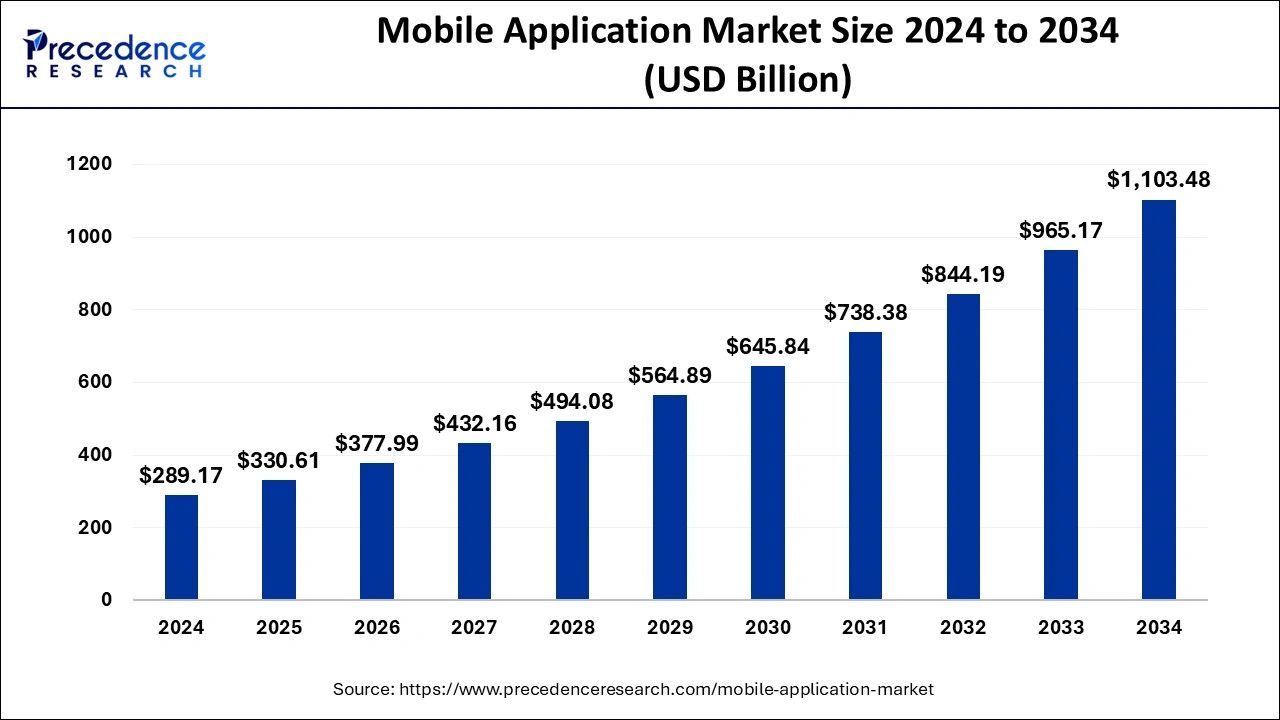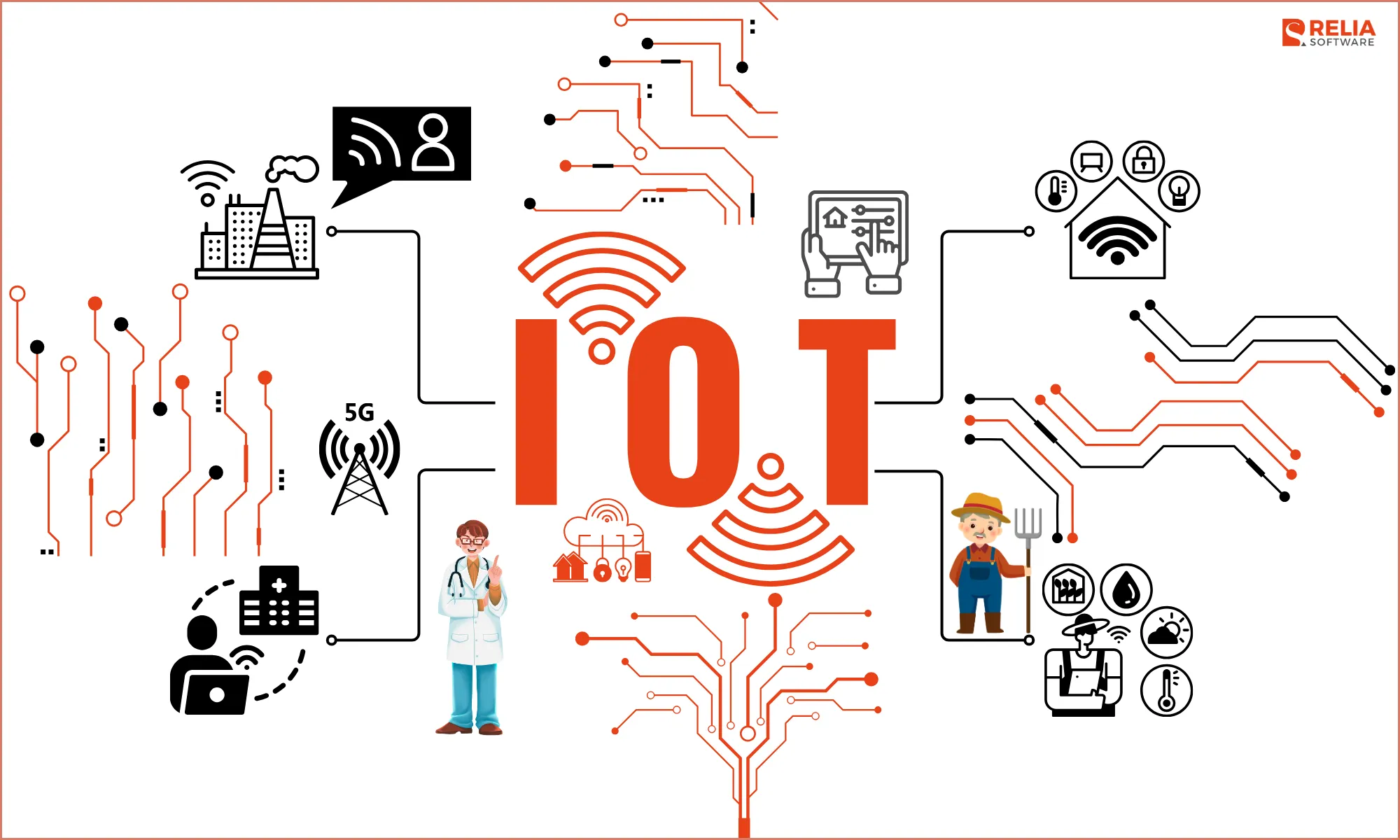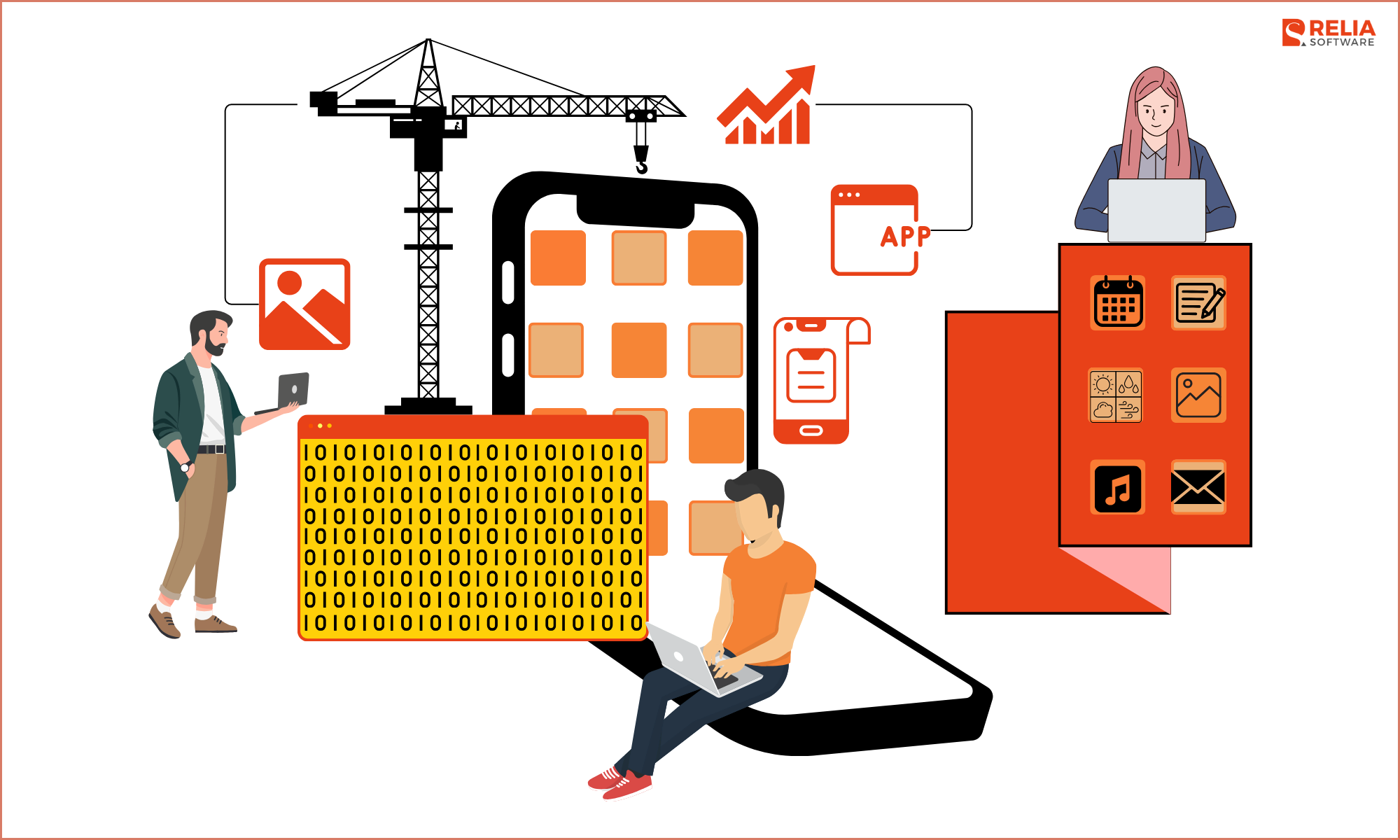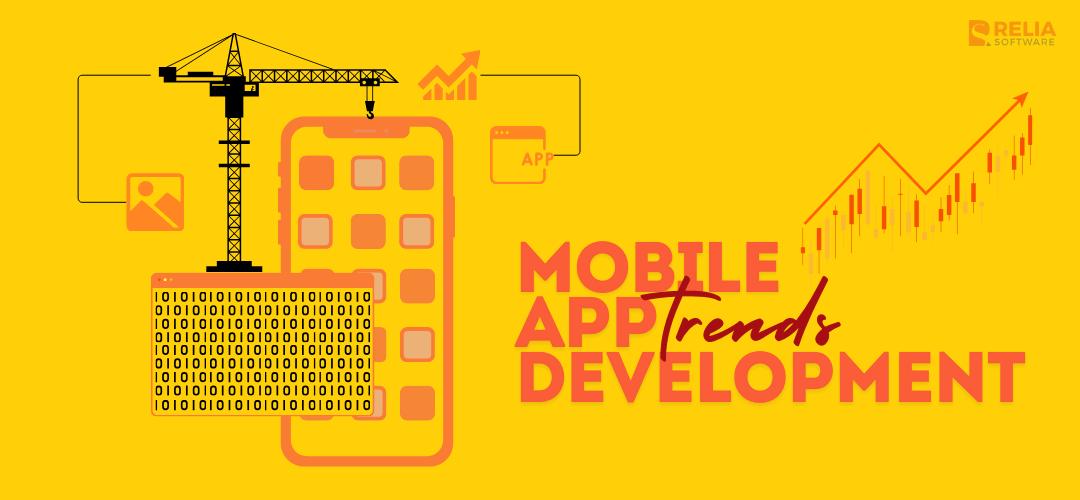Mobile apps have become a big part of our daily lives and change how we communicate, work, shop, and entertain. The industry is growing fast, with the global mobile app market valued at $289.17 billion in 2024. By 2034, it is expected to reach $1,103.48 billion, growing at a CAGR of 21.55%, according to Precedence Research.
With this growth, businesses and developers have to keep up with the latest trends to keep apps competitive. To help you, in this blog, I'll mention the latest mobile app development trends for 2025 and beyond. They are drawn from the latest research and my own analysis.

(Source: https://www.precedenceresearch.com/mobile-application-market)
>> You can consider:
AI Integration
It isn't too much to say we are living in the Artificial Intelligence era, is it? AI is mentioned everywhere, in various industries, and so is mobile app development. According to MindInventory, the AI in mobile apps market is expected to grow from $16.7 billion in 2023 to $249.8 billion by 2033, with a CAGR of 33.7% during the forecast period (2024-2033).
The reason for this growth is that your apps will be much smarter with advanced data analytics and automation. Besides, your user experience will be improved with personalized content and recommendations. Do you know that about 66% of businesses plan to invest in AI to level up their apps? So, why don’t you?
You can apply AI for various use cases such as virtual assistants like Siri and Google Assistant or AI chatbots to provide 24/7 customer support. Additionally, apps like shopping, music, and entertainment can personalize their recommendations with AI. Or, you can see Adobe or TikTok that use AI to edit images and videos effectively.
In short, using AI technology to build mobile apps is a worthwhile investment that you can see in the long term.
>> Read more: Top 10 Leading AI Software Development Companies in Viet Nam
5G Technology
5G is the latest mobile network technology with faster speeds, lower latency, and greater capacity than before. This is not just a single trend, it has big effects on others like IoT, AI, automation, etc. You know, these technologies generate massive data that is predicted to reach hundreds of zettabytes in the coming years, and current mobile networks can’t handle the load. Thus, the demand for 5G increases due to:
- Speeds up to 10 Gbps, 100 times faster than 4G.
- Low latency of 1 millisecond, compared to 50 milliseconds on 4G.
- Supports up to 1 million devices per square kilometer, while 4G handles only 100,000.
- Consume less power, extending battery life on smartphones and wearables.
According to Statista, only 12% of mobile connections worldwide used 5G in 2022, but this is expected to exceed 50% by 2030. Global 5G connections are also set to grow from 1.9 billion in 2023 to 5.9 billion by 2027. These numbers show that 5G will be the new standard for mobile connectivity in the future.
5G can be used in mobile apps for buffer-free 4K/8K streaming, instant cloud gaming, and seamless connectivity for IoT devices and wearables. Besides, AR/VR apps for gaming, shopping, and virtual work, as well as voice assistants and predictive analytics can be also improved with faster speed.
AR/VR
Augmented Reality (AR) and Virtual Reality (VR) are some of the popular future mobile app development technologies that bridge the gap between digital and physical worlds. These technologies improve mobile apps in various sectors like gaming, retail, education, and healthcare with more interactive user experiences.
The global AR and VR market is growing rapidly. By 2025, it’s expected to generate around $46.6 billion in revenue. This growth will continue at a 7.97% annual rate, reaching an estimated $63.5 billion by 2029 (Source: Statista).
In gaming apps, AR/VR brings players into realistic virtual worlds to have a more interactive and engaging experience. Pokémon GO can be seen as the first gaming mobile app using AR.
AR lets customers try on clothes, makeup, or see furniture in their homes before buying, while VR creates virtual shopping malls. Examples like IKEA Place lets users see furniture in real spaces, and L’Oréal’s Style My Hair app lets users preview different hairstyles and colors.
AR can be used in map apps to give real-time directions with digital markers on streets instead of traditional maps. Like, the Live View feature of Google Maps, you’ll know exactly where you are on the screen when pointing your camera at buildings and street signs.

Cloud Computing
Cloud computing is not a new mobile app development trend, but its popularity will continue to grow in the next years. Today, over 80% of companies worldwide use cloud services, and the market is expected to surpass $600 billion by 2025.
You know why? Cloud computing is now no longer just a way to store files or access data remotely. Instead, it is a must-have for AI-driven apps, scalable mobile services, and cross-platform experiences. As mobile apps get smarter and more complex, only relying on devices is not enough.
For example, AI-driven features like chatbots, voice assistants, and personalized recommendations need heavy data processing. Instead of overloading mobile devices, AI models run in the cloud to make responses faster and more accurate. ChatGPT, Google Assistant, and Siri all rely on cloud servers for instant answers.
Moreover, more businesses build apps directly in the cloud (like Uber and Airbnb) to scale easily, perform better, and reduce costs. They also tend to use multi-cloud providers to prevent downtime and boost security.
Finally, cloud computing helps protect user data with AI-driven security, real-time updates, and encryption when cyber threats are rising.
Super Apps
Super apps mean combining multiple services such as messaging, shopping, and financial transactions into a single platform. So, you can do everything in one place instead of switching between multiple applications. They are expected to be one of the top mobile app development trends due to their convenience.
Specifically, the global super app market was valued at $94.9 billion in 2024 and is expected to reach $592.1 billion by 2033, with a CAGR of 20.3% from 2025 to 2033 (Source: IMARC Group). The Asia-Pacific region leads this trend, holding over 46.8% of the market in 2024.
We can name some leading super apps in this trend like:
- X (Twitter): Elon Musk integrates payments, shopping, and AI-driven services to turn X into a global super app.
- WeChat (China) – Offers messaging, payments, social media, and shopping in one app.
- Grab (Southeast Asia): Combines ride-hailing, food delivery, and financial services.
- Gojek (Indonesia): Provides transport, on-demand services, and digital payments.
Well, I think this is a potential trend in the mobile app market in the coming years. You can keep an eye on them to have more competitive ideas for your projects.
IoT (Internet of Things)
IoT technology has been around for years, but it continues to be more popular as more people and businesses look for smarter, more connected solutions. With IoT, mobile apps can control smart devices, collect real-time data, and automate daily tasks. So, everything from homes to workplaces is more efficient.
IoT is now even more powerful when combined with other technologies like near-field communication (NFC), beacons, and sensors. For example, IoT apps let users to control lights, thermostats, security cameras, and appliances remotely. Or, you can remotely start cars, check diagnostics, and provide real-time navigation. Besides, healthcare, fitness, manufacturing, and more can also benefit from IoT.
The IoT market is now growing fast, with an expected 10.17% annual growth (CAGR 2025-2029), reaching $1.56 trillion by 2029 (Source: Statista). So, why don’t you take advantage of this rising demand to use IoT technology to build your mobile app? I believe that the opportunities for innovation and success are bigger than ever.

>> Read more: 10 Best IoT App Development Companies in Vietnam
Apps for Wearables
You have surely heard of wearables for years, right? They are not a new trend, but now no longer just about tracking steps or receiving notifications. Today, wearables are powerful mini-computers that help users in work, healthcare, fitness, and daily life. I think the real potential of wearables just starts to unfold, and mobile apps are at the center of this change.
What I mean is how wearables and mobile apps integrate, in other words, mobile apps in wearables are becoming more independent from those in smartphones. Companies like Apple and Google are rolling out updates that let wearables run apps on their own. Apple’s watchOS now has its own App Store, meaning users can download apps directly on their smartwatches without needing a phone.
Looking ahead, more apps will be built specifically for wearables, making them faster, smarter, and more useful.
Mobile Wallet
Cash is no longer king, and pretty soon, neither will plastic credit cards. With smartphones being a daily necessity, mobile wallets are becoming the go-to payment method for convenience and security.
More people choose fast, contactless, and secure transactions, making mobile wallets the new standard for digital payments. The global mobile wallet and payment market is expected to grow at 27.4% annually from 2023, reaching $71.28 billion by 2031 (Source: ResearchAndMarket). This shows just how big this trend will be in the coming years.
Beyond convenience, mobile wallets are highly secure. They use encryption, biometric authentication, and tokenization, making them safer than traditional payment methods. Many like ApplePay, PayPal, GooglePay, etc. are now integrated into super apps like WeChat and Grab. Users thus pay for rides, shop, and order food—all within one platform.
With businesses rapidly adopting NFC-based contactless payments, mobile wallets are becoming faster, easier to use, and widely accepted. Soon, they will drive the shift toward a fully cashless economy.
Apps for Foldable Devices
Foldable devices these days have brought mobile app development a new trend that changes how users interact with apps on larger, more flexible screens. This means mobile apps have to be built to adapt better to foldable devices without negative impacts on user experience.
For example, mobile apps should have responsive UI design that adjusts easily between compact and expanded screen sizes. Or, they need to support multi-window functionality for users to drag, drop, and split screens.
Samsung, Google, and Huawei are big names driving this trend. As more brands release foldable smartphones, mobile apps will continue to advance to take full advantage of larger, flexible screens. And, do you know? The demands for foldable devices also rise. The foldable smartphone market is estimated at $33.64 billion in 2025 and reaches $74.16 billion by 2030, at a CAGR of 17.13% (Source: Mordor Intelligence).
With these numbers, businesses that optimize their apps early will gain a competitive edge in this growing market.

Beacon Technology
Beacon technology is one of the latest mobile app development technologies providing real-time, location-based interactions. Using Bluetooth Low Energy (BLE) signals, beacons is widely used in retail, hospitality, healthcare, and smart cities to improve customer experience.
I'll explain to you how beacons are used with mobile apps. Like, a retail store installs beacons that connect with customers' smartphones via Bluetooth, but only with the store’s app installed.
When a customer walks past the beacons, they receive a welcome message or a special discount notification encouraging them to check out the latest arrivals. Besides, beacons can track customer behavior. If a shopper spends a long time in the shoe section, the app can send a push notification with a limited-time discount on sneakers.
You see, this real-time engagement helps stores boost sales, enhance customer experience, and encourage repeat visits. According to Fortune Business Insights, the beacon market is expected to reach USD 31.61 billion by 2026 and further expand to USD 231.36 billion by 2031. This shows beacons will be the top technology to build mobile apps in the future.
On-Demand Apps
On-demand apps are mobile applications that connect users with services in real-time. Services can be ordering food, booking a ride, hiring a freelancer, or scheduling a home service. All will be more convenient with instant solutions, secure payment, and real-time tracking.
How an on-demand app work? Simply, a customer opens the app and selects a service (e.g., booking a ride, ordering food, or hiring a freelancer). The app then connects the user with an available service provider nearby. Users can track their order, ride, or service provider’s location in real-time. Finally, payments are made through the app, and users can leave ratings and feedback.
In our fast-paced society, the need for fast and convenient things increases more than ever. On-demand apps will continue to be the top mobile app development trend that can solve this demand. So, for businesses, this is a huge opportunity to grow your customer base and turn your app to the next level.
>> Read more:
- The Role Of On-Demand Delivery In The Market
- How Will On-Demand Delivery Services Impact Retail Stores?
Touchless UI
Touchless UI means we don't need physical touch to interact with mobile apps. Instead, users can use voice commands, facial recognition, gestures, and motion sensors to navigate the app. Sound great, right?
With the rise of AI, IoT, and 5G, touchless interfaces are becoming a key trend in mobile app development. The global gesture recognition and touchless sensing market is expected to reach $37.6 billion by 2028, growing at a CAGR of 23.9% (Source: MarketsandMarkets). Clearly, this is a potential market for building mobile apps that are smarter with faster, safer, and more accessible interactions.
Along with the fast growth of AI, sensors, and machine learning, touchless UI will expand into more fields like gaming, virtual reality, automotive apps, and smart home control. So, investing and integrating touchless interactions early will be a highly competitive chance to stay ahead in mobile innovation.
Superior Security
Mobile app security is more vital than ever with the rise of cyber threats, data breaches, and digital fraud. Besides user-friendly experiences, your mobile apps also need strong security measures to protect your users' personal data.
With mobile app usage increasing, security threats are growing just as fast. In Q3 2023 alone, over 438,000 malicious installation packages were detected on mobile devices (Source: Statista). Recent reports also show that 75% of mobile apps have at least one security flaw, making them easy targets for cyberattacks. Even worse, unpatched vulnerabilities account for 60% of data breaches. (Source: Build38).
You see, these statistics emphasize the necessity for developers and organizations to prioritize security throughout the app development lifecycle. Some security trends can be biometric authentication, end-to-end encryption, zero trust security model, etc.
As mobile threats continue to expand, investing in superior security measures is not just a technical necessity. It is a strategic mobile app development trend to protect user data and the integrity of mobile applications.
>> Read more:
- Top 14 Best Data Security Software For Your Businesses
- In-depth Guide To Cybersecurity in Software Development
Instant Apps
Instant apps allow users to access apps without downloading them. Users can click a “Try Now” button to test features, play games, or complete quick tasks instantly. This approach is helpful for users with limited device storage or those hesitant to download full applications.
First introduced by Android, developers can create instant apps using Android Studio, which provides the necessary tools and SDKs to build lightweight, interactive experiences.
Recognizing the growing demand for instant experiences, Google Play Store now supports Google Play Instant, allowing users to try apps instantly before committing to a full installation. And you know, companies using instant apps report higher engagement, better conversion rates, and lower app abandonment. So, why don’t you catch this trend right now?
Blockchain
Blockchain is changing mobile app development by making apps more secure, transparent, and decentralized. Started with cryptocurrencies like Bitcoin and Ethereum, blockchain is now used in finance, supply chain, healthcare, gaming, and data security to prevent fraud and protect user data.
The global blockchain market is expected to reach $1.4 trillion by 2030, growing at a CAGR of 87.7% (Source: Statista). This rapid growth shows the rising demand for secure and decentralized apps (dApps) that give users more control over their data.
As more industries apply blockchain for better security and efficiency, its role in mobile apps will only grow. Developers who integrate blockchain early will build next-gen apps that are safer, more transparent, and ready for the future.
>> Explore more: What are Advantages and Disadvantages of Blockchain Technology?
Conclusion
Mobile apps are transforming the way we live. People now expect smartphones to do it all—work, communicate, order food, and even control their home with a voice command. What once seemed like science fiction is now reality.
With AI, 5G, IoT, and other future mobile app development trends, developers and businesses who catch up with these technologies early will stay ahead of the competition. If you're looking to enhance your app with the latest advancements, Relia Software is here to help. Contact us today to bring your vision to life!
>>> Follow and Contact Relia Software for more information!
Our email: sales@reliasoftware.com
- Mobile App Development
- Designing an application
- mobile app
- mobile applications

